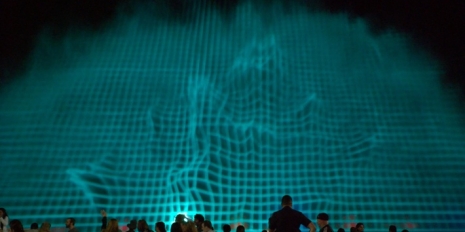
Many people try to avoid Messiness. Some try to solve it, and others try to get rid of it completely. But what Usman Haque will tell you, is that messiness is essential. It’s the life blood of every city and it creates the very fabric that supports a cities culture, diversity and familiarity.
London based architect-come-new-age-digital-hacker, Usman Haque’s was in town this month speaking as part of the Paradigm Shift event at Mills Reef, talking about his journey to give people the power to take back their cities. Usman gave an inspiring presentation of is vision of the new age city as well as many of his interactive projects and is obsession with the Internet of things (IoT). Now the founder of the Umbrellium, Usman works on interactive environments and technological tools to empower citizens in their cities.
Noted as one of the few architects “working on the fringes of architecture” Usman’s aptly named presentation “In Praise of Messy Cities” discussed how we can create a structure of participation within our cities. How can we knit communities and empower people in today’s smart and tech driven cities?
Often we see technological solutions in our cities that promote efficiency and optimization. Usman challenged these solutions to say why should we make solutions that make cities bearable, rather than exciting? Instead of seeing cities as a problem, why don’t we create technological solutions that empower and connect people to support the very “messy city” they live in. Usman’s projects over the last 10 years have done exactly this, using technology to empower people.
Open Burble was a project by Usman that was created and controlled by the people. First unveiled at the Singapore Biennale in 2006, Open Burble was designed to give people the power to redesign their skyline. Crafted with Lights, aluminum poles and helium balloons, people were able to create an interactive structure that floated up 18 story’s high. The structures shape was designed by participants, the light show was controlled by the participants, and it required 200 people to hold it down at any one time meaning every person’s contribution played an integral part.
Chinatown flea markets might not seem the most obvious source for an installation, but it was key to Usman’s next project: The Reconfigurable House. Founded on 1000’s of simple parts, the open software and hardware environment was a critique of the smart home. Instead of a pre wired house, people got to easily stich cheap sensors from toys such as Cats and Penguins to determine all kinds of interesting responses from light, sound, touch in a low tech framework. One of Usman’s key messages here, is that you must design for granularity. You must give people with all different backgrounds and skills the ability to interact with technology at the simplest level. This incentivises them to move up the chain to learn and involve themselves in more challenging problems.
With Usman’s project Listening NYC, Usman took to the task of reconfiguring how New Yorkers filed noise complaints. Rather than just filing a complaint, Usman’s team designed an application that created a “frequency fingerprint” of the city. Instead of only recording annoying sounds, people were asked to record sounds, describe them and rate them throughout New York. This then provided a sound map of New York City, where people could find places to hear certain sounds, or show places to avoid. It allowed people to celebrate the sounds of the city through collaboration.
One of Usman’s most successful claims to fame was the founding of Pachube (now xively) in 2007. Pachube was one of the first services to open the internet of things up to the consumer. It allowed users to “quickly connect products and operations to the Internet” and facilitated the pushing and pulling of data from applications and devices. Pachube came into its own in the 2012 Japan radiation crisis when users began connecting Geiger counters and radiation montors to share data across Japan. People then began to map this data with weather sensors to create radiation maps and other visualization tools to predict the effect of radiation across Japan. The connectivity allowed people to make sense of a phenomenon that the Japan government could not react to fast enough.
After selling pachube, Usman set up the website Thingful, a new search engine for the Internet of Things. It allows people to make use of the readily available public data on sensors and device across the globe. This gives people access to all kinds of data, from the weather in Mt Maunganui, to speed and direction of a container ship in the Atlantic, to the number of twitters followers of Lars Anderson has in SanFranscico. It does all this with a beautiful interface plugged into google maps. Connectivity to these global devices is the scary reality of the internet of things.
Listening to Usman speak, you can tell he has strong understanding of how is work can have a profound influence on people to behave and utilize space in different ways. Allowing people to control and create their environments encourages creative diversity and gives people ownership of the issues. His passionate talk should serve as a wakeup call to many architecture practices today, showing that innovation can delve further than the four walls of the family home. Creating playful qualities within architecture can help drive human interaction and get people to appreciate the mess of their own city.
Usman left us with 5 points to get onboard with his approach to cities.
GET PEOPLE TO:
Finally, Usman told us to make mess.
Comments
Post new comment